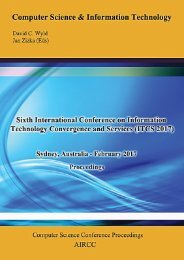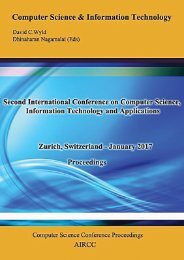CoSIT 2017
Fourth International Conference on Computer Science and Information Technology ( CoSIT 2017 ), Geneva, Switzerland - March 2017
Fourth International Conference on Computer Science and Information Technology ( CoSIT 2017 ), Geneva, Switzerland - March 2017
You also want an ePaper? Increase the reach of your titles
YUMPU automatically turns print PDFs into web optimized ePapers that Google loves.
Computer Science & Information Technology (CS & IT) 137<br />
Figure 6: R 2 score as a function of the fields used for learning features<br />
To accurately compare our results to the work done in [7], we ran an experiment in which the<br />
target field was calculated in hours and the defects were categorized into Fast and Slow defects<br />
using the median of fixing time. Similarly, in this experiment we calculated the median for each<br />
project and partitioned the defects into two classes, we used the measures described in [7], and<br />
used a Random Forest Classifier with parameters close to those used for our regresssor (described<br />
in Section 1). The results presented in Table 3 are the average over all projects in our dataset, and<br />
the average results over all projects presented in the compared work when the initial defect data<br />
was used. Their data set contained six open source projects, with a similar number of defects to<br />
the current paper. Our results show an improvement over the reported results in the compared<br />
study.<br />
Table 3: Performance comparison<br />
7. VALIDITY<br />
In this section we discuss the validity of our work by addressing the threats for validity of<br />
software engineering research proposed by Yin in [17].<br />
Construct Validity. Our construct validity threats are mainly due to inaccuracies in calculating<br />
handling times, based on information stored in defect tracking systems. This is due to the "human<br />
factor": developers are expected to update the systems, often manually, to reflect the real work<br />
process, and have different expertise levels and variable work availability and productivity.<br />
Internal Validity. Methods such as cross-validation were used to make sure the results are as<br />
accurate as possible. In cases where a phenomenon had alternative explanations (e.g. comparison





